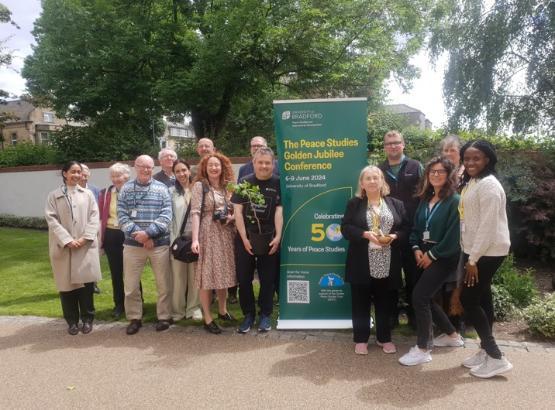Sapling of Hiroshima survivor tree planted to mark university’s 50 years of Peace Studies

A sapling grown from the seed of a tree that survived the Hiroshima bomb has been planted at the University of Bradford to commemorate 50 years of its Peace Studies department.
The ginkgo tree seedling, planted in the Peace Garden on campus, was donated by Bradford alumni Richard Outram, Secretary of the UK and Ireland Mayors for Peace, a network of 8,500 cities and towns that work to promote peace and which also calls for the abolition of nuclear weapons.
Mr Outram said: “This is the 17th such sapling I have seen planted but for me this planting is very special because as a mature student, I attended Peace Studies from 2017 to 2021 and I became an honours graduate that year.
“The mother tree of this sapling is a ginkgo tree in the city of Hiroshima and it is a tree which survived the atomic bombing of that city on 6 August 1945.
“Although physical buildings of that city were devastated and 70,000 of its inhabitants were almost immediately killed - with a further 70,000 fatalities before the end of that year - some of the trees about the epicentre of the blast, a point above Shima Hospital - amazingly survived and not only survived but thrived.”

He added: “We received 17 saplings from Japan… 16 have already been planted in other towns, so this is the last one. I cannot think of a more fitting place to put it. This tree symbolises the hope that… there must be a nuclear free and peaceful world if our planet is to survive.”
Also attending the ceremony were around a dozen guests, including Professor Fiona Macaulay and Dr Becky Alexis-Martin, both from the University of Bradford's Department for Peace Studies and International Development.
Dr Alexis-Martin said: “The planting of the ginkgo sapling was part of our Golden Jubilee Conference to mark the end of a year-long celebration commemorating the 50th anniversary of peace studies at Bradford. Its very existence is symbolic of resilience and hope and as it grows we will be constantly reminded of our commitment to resolving conflict and promoting a peaceful world.”
The tree comes with a plaque explaining its provenance, and a QR code showing the location of its mother tree in Hiroshima.

Survivor trees
In Hiroshima, city authorities recorded 160 surviving trees within 2km of the epicentre of the blast - these are called Hibaku, or ‘survivor trees’.
The mother tree of the Bradford sapling, which was left slanted by the blasts, is estimated to be around 200-years-old and is located in Shukkeien Gardens, once the formal recreational garden reserved for the use by the Lord of Hiroshima Castle, which was destroyed in the blast but has since been rebuilt.
